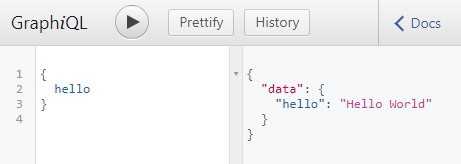GraphQL 简介:原理及其使用
2019年03月11日 译者:zhangxinmei
GraphQL 是 API 的查询语言,它显示了服务器提供的不同类型的数据,然后客户端可以准确地选择它想要的内容。
同样在 GraphQL 中,你可以一次性调用多个服务器资源,而不在需要进行多个 REST API 调用。
你可以通过访问 https://graphql.org/ 来了解 GraphQL 的所有优点。我们必须在实践中使用 GraphQL,否则你很难理解它的优点,那么现在就让我们开始使用 GraphQL 吧~
我们将在本文中使用 GraphQL 和 NodeJS。
先决条件
安装 NodeJS:https://nodejs.org/en/
如何将 GraphQL 与 NodeJs 一起使用?
GraphQL 可以与多种语言一起使用,这篇文章中,我们将重点介绍如何通过 NodeJS 将 GraphQL 与 JavaScript 结合使用。
新建一个名为 graphql-with-nodejs 的文件夹,进入项目文件夹并运行 npm init 来创建 NodeJS 项目,终端命令如下:
cd graphql-with-nodejs
npm init安装依赖项
使用以下命令安装 Express:
npm install express我们将使用以下命令安装 GraphQL 和 GraphQL for Express:
npm install express-graphql graphqlNodeJS 代码
在项目中创建一个名叫 server.js 的文件,并将以下代码复制到其中:
const express = require("express");
const port = 5000;
const app = express();
app.get("/hello", (req, res) => {
res.send("hello");
});
app.listen(port);
console.log(`Server Running at localhost:${port}`);上面的代码有一个名为 /hello 的 HTTP GET 请求,这个请求是使用 Express 创建的。现在,让我们修改此代码来启用 GraphQL。
在代码中启用 GraphQL
GraphQL 有一个名为 /graphql 的单一的 URL 资源路径,它将处理所有的请求。
将以下代码复制到 server.js 中:
//get all the libraries needed
const express = require("express");
const graphqlHTTP = require("express-graphql");
const { GraphQLSchema } = require("graphql");
const { queryType } = require("./query.js");
//setting up the port number and express app
const port = 5000;
const app = express();
// Define the Schema
const schema = new GraphQLSchema({ query: queryType });
//Setup the nodejs GraphQL server
app.use(
"/graphql",
graphqlHTTP({
schema: schema,
graphiql: true
})
);
app.listen(port);
console.log(`GraphQL Server Running at localhost:${port}`);现在让我们来看看这段代码吧~
graphqlHTTP 使我们能够在 /graphql url 中设置 GraphQL 服务器,它知道如何处理即将发生的请求。这个设置在以下代码行中完成:
app.use(
"/graphql",
graphqlHTTP({
schema: schema,
graphiql: true
})
);现在,让我们一起来探索 graphqlHTTP 中的参数吧~
graphiql
graphiql 是一个 Web UI,您可以使用它来测试 GraphQL 资源路径。我们将其设置为 true,以便更容易测试我们创建的各种 GraphQL 请求路径。
schema
GraphQL 有一个外部资源路径 /graphql,这个资源路径可以有多个其他资源路径执行各种操作,这些资源路径可以在 schema 中被指定。
schema 将执行以下操作:
-
指定资源路径
-
指示资源路径的输入和输出字段
-
指示在命中资源路径时应执行的操作,依此类推
schema 在代码中定义如下:
const schema = new GraphQLSchema({ query: queryType });schema 可以包含 Query 和 Mutation 类型,但是这篇文章将仅关注 Query 类型。
查询(query)
你可以在 schema 中看到查询已设置为 queryType,我们使用以下命令从 query.js 文件中导入 queryType:
const { queryType } = require("./query.js");query.js 是我们即将创建的自定义文件,query 是我们在 schema 中指定只读请求路径的地方。
在项目中新建一个名为 query.js 的文件,并将以下代码复制到其中:
const { GraphQLObjectType, GraphQLString } = require("graphql");
//Define the Query
const queryType = new GraphQLObjectType({
name: "Query",
fields: {
hello: {
type: GraphQLString,
resolve: function() {
return "Hello World";
}
}
}
});
exports.queryType = queryType;查询说明
queryType 创建为 GraphQLObjectType 并命名为 Query。fields 是我们指定各种资源路径的地方,因此我们在这里添加一个名为 hello 的资源路径,hello 有一个 GraphQLString 类型,这意味着该资源路径的返回类型为 String。这里的类型是 GraphQLString 而不是 String,因为这是 GraphQL scheme,因此直接使用 String 是不行的。
resolve 函数表示调用请求时要执行的操作,这里的操作是返回一个字符串 Hello World。
最后,我们用 exports.queryType = queryType 导出 querytype,这是为了确保我们可以在 server.js 中导入它。
运行应用程序
使用以下命令运行应用程序:
node server.js你可以通过访问 localhost:5000/graphql 本地运行和测试该程序。
此 URL 在 Graphiql Web UI 中运行,如下图所示:
左边输入相应查询,右边为相应的输出,输入以下查询:
{
hello;
}对应的输出如下:
{
"data": {
"hello": "Hello World"
}
}恭喜你!😃
你已经创建了第一个 GraphQL 资源路径。
添加更多资源路径
我们将会创建 2 个新的资源路径:
-
movie:这个资源路径将会返回指定 ID 的电影
-
director:这个资源路径将返回指定 ID 的导演,还将返回该导演指导的所有电影。
添加数据
通常,一个应用程序将从数据库中读取数据,但是在本教程中,我们将简单地对代码本身中的数据进行硬编码。
创建一个名为 data.js 的文件,并添加以下代码:
//Hardcode some data for movies and directors
let movies = [
{
id: 1,
name: "Movie 1",
year: 2018,
directorId: 1
},
{
id: 2,
name: "Movie 2",
year: 2017,
directorId: 1
},
{
id: 3,
name: "Movie 3",
year: 2016,
directorId: 3
}
];
let directors = [
{
id: 1,
name: "Director 1",
age: 20
},
{
id: 2,
name: "Director 2",
age: 30
},
{
id: 3,
name: "Director 3",
age: 40
}
];
exports.movies = movies;
exports.directors = directors;此文件包含 movies 和 directors 数据,我们将使用此文件中的数据作为我们请求所需的数据。
将 movie 资源路径添加到查询中
新的资源路径将被添加到 query.js 文件中的 queryType 中。
movie: {
type: movieType,
args: {
id: { type: GraphQLInt }
},
resolve: function (source, args) {
return _.find(movies, { id: args.id });
}
}这个请求的返回类型是 movieType,args 参数用于指示 movie 资源路径的输入,这个资源路径的输入是 id,其类型为 GraphQLInt。resolve 函数从电影列表中返回与 id 相匹配的电影。find 是 lodash 中的一个函数,用于查找列表中的元素。
query.js 的完整代码如下所示:
const { GraphQLObjectType, GraphQLString, GraphQLInt } = require("graphql");
const _ = require("lodash");
const { movieType } = require("./types.js");
let { movies } = require("./data.js");
//Define the Query
const queryType = new GraphQLObjectType({
name: "Query",
fields: {
hello: {
type: GraphQLString,
resolve: function() {
return "Hello World";
}
},
movie: {
type: movieType,
args: {
id: { type: GraphQLInt }
},
resolve: function(source, args) {
return _.find(movies, { id: args.id });
}
}
}
});
exports.queryType = queryType;从上面的代码中,我们可以看到 movieType 实际上是在 types.js 中定义的。
添加自定义类型 movieType
创建一个名为 types.js 的文件,并添加以下代码:
const {
GraphQLObjectType,
GraphQLID,
GraphQLString,
GraphQLInt
} = require("graphql");
// Define Movie Type
movieType = new GraphQLObjectType({
name: "Movie",
fields: {
id: { type: GraphQLID },
name: { type: GraphQLString },
year: { type: GraphQLInt },
directorId: { type: GraphQLID }
}
});
exports.movieType = movieType;可以看出 movieType 是以 GraphQLObjectType 创建的,它有 4 个字段:id,name,year 和 directorId,在添加这些字段时,也会指定每个字段的类型。这些字段直接从数据中来的,在我们的这个例子中,它将来自电影列表。
为 director 资源路径添加查询和类型
和 movie 一样,我们甚至还可以添加 director 资源路径。在 query.js 中,可以按如下方式添加 director 资源路径:
director: {
type: directorType,
args: {
id: { type: GraphQLInt }
},
resolve: function (source, args) {
return _.find(directors, { id: args.id });
}
}可以在 types.js 中添加 directorType 代码:
//Define Director Type
directorType = new GraphQLObjectType({
name: "Director",
fields: {
id: { type: GraphQLID },
name: { type: GraphQLString },
age: { type: GraphQLInt },
movies: {
type: new GraphQLList(movieType),
resolve(source, args) {
return _.filter(movies, { directorId: source.id });
}
}
}
});等等,directorType 与 movieType 略有不同?这是为什么呢?为什么在 directorType 中有 resolve 函数?以前我们看到 resolve 函数只出现在查询中…
directorType 的特殊性
当 director 资源路径被调用时,我们必须返回导演的详细信息,以及该导演指导的所有电影。directorType 中的前 3 个字段 id,name,age 直接从导演列表中获取数据,第 4 个字段 movies 需要包含这位导演的电影列表。为此,我们提到的 movies 字段的类型是 GraphQLList 中的 movieType。
但是我们究竟如何找到这位导演导演的所有电影呢?
为此,我们在 movies 字段里面定义了一个 resolve 函数,resolve 函数的输入参数是 source 和 args,source 将具有父对象的详细信息。
这时候我们让 director 的 id =1, name = “Random” ,age = 20,并且 source.id = 1,source.name =“Random”,source.age = 20。
因此,在这个例子中,resolve 函数找出了 directorId 与所需 Director 的 Id 匹配的所有影片。
代码
GitHub repo 提供了这个项目的完整代码。
应用程序测试
现在让我们测试不同场景的应用程序,使用 node server.js 运行这个程序,本地访问 localhost:5000/graphql 并尝试输入以下内容。
movie
输入:
{
movie(id: 1) {
name
}
}输出:
{
"data": {
"movie": {
"name": "Movie 1"
}
}
}输出:
{
"data": {
"director": {
"name": "Director 1",
"id": "1",
"age": 20
}
}
}从上面我们可以看到客户端可以准确地请求它想要的数据,GraphQL 将确保只返回那些想要的参数。这里仅请求 name 字段,并且仅由服务器返回。
在 movie(id:1) 中,id 是输入参数,我们要求服务器返回 id 为 1 的电影。
输入:
{
movie(id: 3) {
name
id
year
}
}输出:
{
"data": {
"movie": {
"name": "Movie 3",
"id": "3",
"year": 2016
}
}
}上面的例子中,请求的字段是:name,id 和 year,所以服务器返回所有这些字段。
director
输入:
{
director(id: 1) {
name
id,
age
}
}输出:
{
"data": {
"director": {
"name": "Director 1",
"id": "1",
"age": 20
}
}
}输入:
{
director(id: 1) {
name
id,
age,
movies{
name,
year
}
}
}输出:
{
"data": {
"director": {
"name": "Director 1",
"id": "1",
"age": 20,
"movies": [
{
"name": "Movie 1",
"year": 2018
},
{
"name": "Movie 2",
"year": 2017
}
]
}
}
}通过上面的例子,我们看到了 GraphQL 的强大功能。我们想要查找一个 id 为 1 的导演,另外,我们想要找出这位 id 为 1 的导演的所有电影。 director 和 movie 字段都是可定制的,客户可以准确地定制他们想要的字段。
同样,我们还可以扩展到其他字段和类型。例如,我们可以运行一个查询查找 id 为 1 的导演,并根据这位导演找到他所有的电影,再为每部电影找到相对应的演员,并且找出每个获得评级前 5 名的演员所参演的电影,依此类推。对于此查询,我们需要指定类型之间的关系,一旦我们这样做,客户端就可以查询它想要的任何关系。
恭喜 😃
你现在已经了解了 GraphQL 的基本概念。你可以通过查看官方文档来了解有关 GraphQL 的更多信息。
关于原作者
LinkedIn:https://www.linkedin.com/in/aditya1811/
twitter:https://twitter.com/adityasridhar18
FENews 是由一群热爱技术的前端小伙伴自发组成的团队。团队会定期创作和翻译前端相关的技术文章,同时我们也欢迎外部投稿或加入我们的核心编辑团队。如果您对我们感兴趣,请关注我们的公众号:


